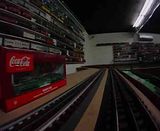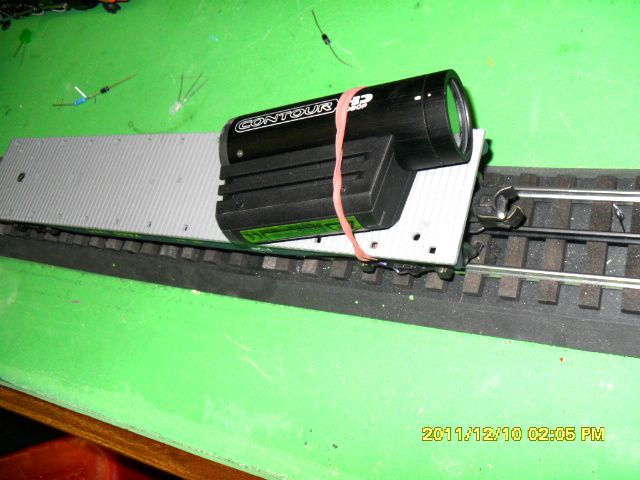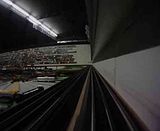Thanks for any info
Sean
|




|
Replies sorted oldest to newest

quote:Originally posted by gunrunnerjohn:
Here's a lot cheaper option that you can install yourself.
quote:Originally posted by gunrunnerjohn:
The easiest way is to tap off track power and use a full wave bridge, an electrolytic cap, and a three terminal regulator.
You take the rectifier bridge, wire the track pickups to the AC terminals, they're the ones with the sine wave symbol on them. The DC comes out on the + and - terminals. Connect the electrolytic across those terminals with the proper polarity. Connect the input of the three terminal 9V regulator to the + side, the ground to the - side, and the output and ground supplies 9 volts. Here's a circuit drawing, you can use diodes or the bridge component. The capacitors are 47uf 50V electrolytics, and the regulator is an LM7809 or similar in the TO-92 package.quote:Originally posted by jjm:
"The easiest way is to tap off track power and use a full wave bridge, an electrolytic cap, and a three terminal regulator."
And there you have it.
Now, for those of us less well-versed in such things, how does one assemble this?



quote:Originally posted by gunrunnerjohn:You take the rectifier bridge, wire the track pickups to the AC terminals, they're the ones with the sine wave symbol on them. The DC comes out on the + and - terminals. Connect the electrolytic across those terminals with the proper polarity. Connect the input of the three terminal 9V regulator to the + side, the ground to the - side, and the output and ground supplies 9 volts. Here's a circuit drawing, you can use diodes or the bridge component. The capacitors are 47uf 50V electrolytics, and the regulator is an LM7809 or similar in the TO-92 package.quote:Originally posted by jjm:
"The easiest way is to tap off track power and use a full wave bridge, an electrolytic cap, and a three terminal regulator."
And there you have it.
Now, for those of us less well-versed in such things, how does one assemble this?
Ignore the 5V in my picture, it was for a 5V design, the 9V is identical except the part is different. The transformer illustrated is your track voltage.

Well, I knew this, but it's certainly good to mention, that was an omission on my part.quote:Originally posted by rrman:
Just make sure that the track ground common is not crossed with the ground symbol wires. In other words two wires from the power roller and truck frame common, and two wires out 9V and ground. But then you already knew this right?
John,
Does the signal from the camera to the receiver of the Tiny 2.4ghz wireless camera require line-of-sight to work? Would Plaster of Paris or pink foam insulation tunnel walls interefere with the signal?
Thanks
Alex
I bought one of these little cameras but now discover that the TV I planned to use does not have a “component” input. Is there a way to use this with a coaxial cable input?
If the camera outputs component (red/green/blue RCA cables), and your TV only has a coaxial connector, you're generally out of luck. The camera is probably outputting video at a higher resolution that the TV you're planning to use (an old unused set, right?) is capable of displaying anyway.
It's technically possible to string together a bunch of converter boxes to possibly get a standard-def composite output, then use an old VCR or an RF converter to get a coaxial connector. Chances are by then you may be better off getting a smalll LCD digital tV which is pretty much guaranteed to have a component input.
---PCJ
Ed you can get a component to RF converter that they used for dvd's or games. It converts the signal to channel 3 or 4 to your tv. If they still make it was available at Radio shack . Hope this helps, Vic.
Can you get a clean signal on your TV? The problem with the older cameras at least was the noise spikes generated by the sparking rollers would interfere with the broadcast signal. Not a problem for a camera with on board memory used for later play back.
Pete
Depending on how large the layout is, you can get some interference as it runs. I'm looking into the higher end models that are used for model airplanes and have a 1 mile or more range, they might be more solid.
John,
Does the signal from the camera to the receiver of the Tiny 2.4ghz wireless camera require line-of-sight to work? Would Plaster of Paris or pink foam insulation tunnel walls interefere with the signal?
Thanks
Alex
No, but you would have to light your tunnel somehow to see anything.
John
Thanks Subway Vic. I bought a modulator at Radio Shack and it now works quite well. I do lose the signal in parts of a tunnel but, as someone mentioned, it would be dark in there anyway. It works very well around the rest of the track. The only problem is that the lighting on my layout is not very bright and the picture is rather dark. I will have to think about whether I want to change the lighting.
Access to this requires an OGR Forum Supporting Membership
